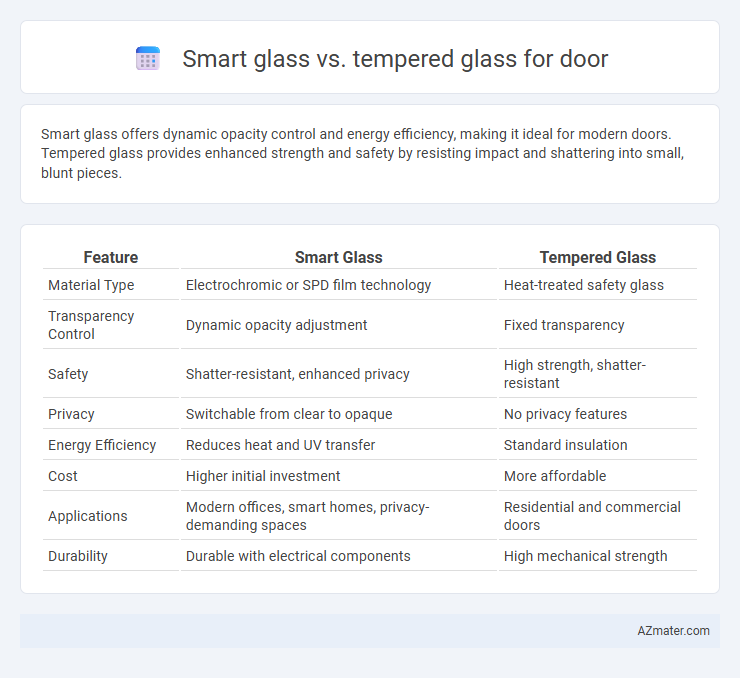Smart glass offers dynamic opacity control and energy efficiency, making it ideal for modern doors. Tempered glass provides enhanced strength and safety by resisting impact and shattering into small, blunt pieces.
Table of Comparison
| Feature | Smart Glass | Tempered Glass |
|---|---|---|
| Material Type | Electrochromic or SPD film technology | Heat-treated safety glass |
| Transparency Control | Dynamic opacity adjustment | Fixed transparency |
| Safety | Shatter-resistant, enhanced privacy | High strength, shatter-resistant |
| Privacy | Switchable from clear to opaque | No privacy features |
| Energy Efficiency | Reduces heat and UV transfer | Standard insulation |
| Cost | Higher initial investment | More affordable |
| Applications | Modern offices, smart homes, privacy-demanding spaces | Residential and commercial doors |
| Durability | Durable with electrical components | High mechanical strength |
Introduction to Smart Glass and Tempered Glass
Smart glass, featuring electrochromic or photochromic technology, allows dynamic control of transparency and light transmission, enhancing privacy and energy efficiency in doors. Tempered glass undergoes heat treatment to increase strength and safety, shattering into small, non-dangerous pieces upon impact, making it ideal for security and durability. Both materials offer unique benefits for door applications, balancing innovation and safety according to architectural needs.
How Smart Glass Works for Doors
Smart glass for doors operates using electrochromic technology, allowing the glass to change transparency states when an electric current is applied, providing instant privacy or clear views on demand. This dynamic control over light transmission enhances energy efficiency by reducing heat and glare without compromising natural light. Unlike tempered glass, which is static and primarily focused on safety and strength, smart glass adds functionality by integrating electronically controlled opacity suited for modern, versatile door designs.
Key Features of Tempered Glass Doors
Tempered glass doors offer enhanced strength and safety due to the heat-treatment process, making them resistant to impact and thermal stress. They shatter into small, blunt pieces upon breakage, significantly reducing injury risk compared to regular glass. Key features include high durability, improved security, and compliance with building safety codes, making tempered glass an ideal choice for door applications.
Durability: Smart Glass vs Tempered Glass
Smart glass offers moderate durability with its ability to withstand everyday impacts and resist scratches, but it remains more vulnerable to damage from sharp objects compared to tempered glass. Tempered glass is engineered through a heat treatment process, enhancing its strength up to four times that of regular glass, making it highly resistant to breakage and ideal for doors subjected to frequent use or potential impact. While tempered glass shatters into small, blunt pieces for safety, smart glass's unique technology focuses more on functionality than impact resistance, making tempered glass the superior choice for durability in door applications.
Privacy and Security Comparison
Smart glass offers dynamic privacy control by switching from transparent to opaque with an electric command, enhancing security by preventing visibility without physical barriers. Tempered glass provides robust physical security due to its strength and shatter resistance but lacks adjustable privacy features, maintaining constant transparency. For door applications, smart glass excels in customizable privacy while tempered glass prioritizes durability and breakage prevention.
Energy Efficiency and Insulation Benefits
Smart glass for doors provides superior energy efficiency by dynamically controlling solar heat gain and reducing the need for artificial cooling or heating, which lowers energy consumption. Tempered glass offers enhanced safety and strength but lacks the adaptive insulation properties of smart glass, resulting in higher heat transfer and increased energy costs. Smart glass's ability to switch between transparent and opaque states optimizes thermal insulation and maintains indoor comfort, making it a more sustainable choice for energy-conscious buildings.
Aesthetic Options and Customization
Smart glass offers dynamic opacity control, allowing users to switch between transparent and frosted states for enhanced privacy and modern aesthetic appeal. Tempered glass provides a variety of finishes and patterns, including tinted, frosted, and textured options, enabling traditional customization with increased safety and durability. Both materials support tailored designs, but smart glass excels in adaptable visual effects, while tempered glass emphasizes consistent style and robust performance.
Installation Process and Maintenance
Smart glass installation requires integrating electronic wiring and control systems, making it more complex and time-consuming compared to tempered glass, which involves standard glazing techniques and simpler framing. Maintenance of smart glass demands regular checks on electrical components and cleaning with non-abrasive materials to prevent damage to the film, whereas tempered glass typically only requires routine cleaning and inspection for chips or cracks due to its durable, heat-treated structure. Proper installation and upkeep of smart glass ensure optimal functionality of its opacity control, while tempered glass offers a low-maintenance, high-strength solution for door safety.
Cost Analysis: Upfront and Long-Term Investment
Smart glass doors have a higher upfront cost, often ranging from $100 to $200 per square foot, due to advanced technology and installation complexity. Tempered glass doors are more affordable initially, typically costing $30 to $50 per square foot, but lack dynamic features. Long-term investment in smart glass may result in energy savings and privacy benefits that offset upfront expenses, whereas tempered glass offers durability with minimal maintenance costs.
Choosing the Right Glass Door for Your Needs
Smart glass offers dynamic control over privacy and light transmission, ideal for modern homes or offices seeking energy efficiency and customizable ambiance. Tempered glass provides superior strength and safety, making it the preferred choice for high-traffic areas or environments requiring enhanced durability and impact resistance. Selecting between smart glass and tempered glass depends on prioritizing functionality such as energy savings and privacy versus maximizing safety and toughness in your door installation.

Infographic: Smart glass vs Tempered glass for Door
 azmater.com
azmater.com